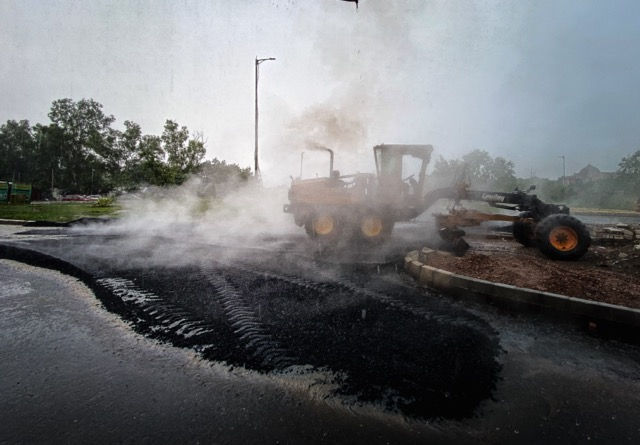Net-zero Targets And The Case of Construction Workers
- Rishabh Shrivastava
- Apr 12, 2024
- 4 min read
Updated: Dec 5, 2024
India’s construction industry employs nearly 60 million people but many lack skills to keep pace as the sector turns green

Rishabh Shrivastava

Picture by : Anindito Mukherjee
The buildings and construction sector accounts for 25.6 % of greenhouse gas emissions and constitutes 30 % of the total energy demand in India, a recent study has shown. These emissions and energy demand are only expected to grow as most of the buildings that will exist in India in 2050 are yet to be built.
The sector is the second largest provider of employment in India, after agriculture, providing jobs to 59 million people, many of them migrants. Some estimates suggest that currently 84 % of the construction workforce is either low-skilled, semi-skilled, or unskilled.
And therein lies the ‘just transition’ challenge. For the sector to decarbonise to cut planet-heating emissions, workers would need to learn new skills to protect their livelihoods as the sector takes a green turn.
But what is net zero and why are countries committing to it?
Net zero means achieving a balance between the carbon emitted into the environment and the carbon removed from it.
In recent times, several countries have committed to achieving net zero targets. India has pledged to reach this target by 2070.
The push for net zero is primarily because of the landmark Paris Agreement in 2015 which was signed by 196 countries and is a legally binding international treaty on climate change. The agreement puts onus on the countries to limit temperature increase to 1.5 degrees Celsius.
It is in line with this objective that countries have been developing and implementing their roadmaps to achieve net zero targets.
How would net zero targets affect climate change?
Latest research shows that to limit the temperature rise to 1.5 degrees Celsius, net zero will have to be achieved between 2050 and 2060. The timeline becomes crucial for bigger emitters like the US and China to ensure that their emissions peak sooner - or the point after which carbon emissions start falling - and they reach their net-zero targets by 2050 or before. Not every country needs to reach its net zero targets by 2050 and it depends on several factors such as historical emissions, per capita emissions, means and resources to mitigate, industrial size among others.
Reaching net zero in 2050 or closer will temporarily avoid the risk of temperature rise to 1.5 degrees Celsius. However, reaching the net zero target in 2060 or later will lead to surpassing the 1.5 degrees Celsius mark.
How are different sectors contributing to climate change in India?
When we talk about carbon emissions, it is important to understand which activities generate a higher load of these emissions and what mitigation measures could be suitable for such sectors or activities.
In India, the largest contributor to GHG emissions is the energy sector (76%) followed by agriculture (13%), industry (8%) and waste (2%).

Under these are various sub-sectors like power generation, transport, mining, oil and gas, construction among others, which are responsible for carbon emissions. For instance, under energy, power generation alone accounted for 45% of emissions in 2018 followed by industrial energy at 26% and transport at 12%.

Similarly, under the industrial processes sector, the mineral industry accounted for 61% of carbon emissions of which cement production stood the highest at 55%.
As per the Adaptation Communication prepared by the Government of India, the building and construction sector alone accounted for 17% of total greenhouse gas emissions in the country in 2019.
What are the steps India is taking to decarbonise the sector?
The building and construction sector in India is witnessing an unprecedented growth rate to feed an ever-growing demand for housing in the world’s most populous country, raising concerns of its growing carbon footprint.
The government has introduced Green Rating for Integrated Habitat Assessment (GRIHA) assess the life cycle of a building. It aims to minimize resource consumption and waste generation of buildings. It has also brought in India Cooling Action Plan to reduce cooling demand and improve energy efficiency using better technology options, and Energy Conservation Building Code, 2017 to make buildings energy efficient by making structural changes to the designs of their walls and windows while also ensuring there is no over-cooling or heating, for energy savings between 25 and 50%.
These changes in the sector require new skill sets among workers that they currently lack to ensure a just transition. For instance, masonry workers need to learn how to install and maintain decentralized solar power system. Phasing out of traditional clay bricks for eco-friendly fly ash has put workers at traditional brick kilns at risk of losing their jobs.
A large part of the construction industry’s workforce comes from rural India where mounting distress owing to losses in agriculture owing to weather extremes have pushed many to cities to earn a living.
Globally, labour unions have started stressing on the need to create frameworks to ensure those traditionally working in the sector are not left behind and should be given new skills in new technologies, processes and equipments.
India’s Ministry of Housing and Urban Development’s National Initiative for Promoting Upskilling of Nirman workers (construction workers) aims to train over 100,000 construction workers and equip them with the skills needed for adopting new construction technology. Private companies such as Larsen & Toubro, one of the largest construction groups in the country, has been providing structured training to upskill its workforce in India.
Rishabh Shrivastava is a researcher and writer working on issues of law, policy and development


Comments